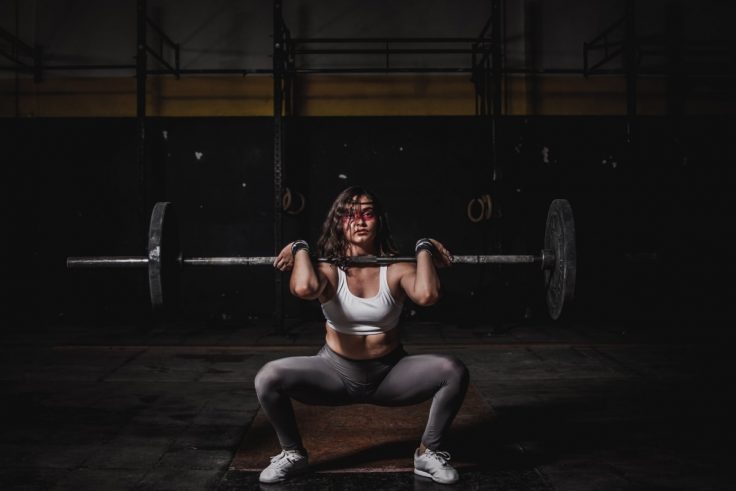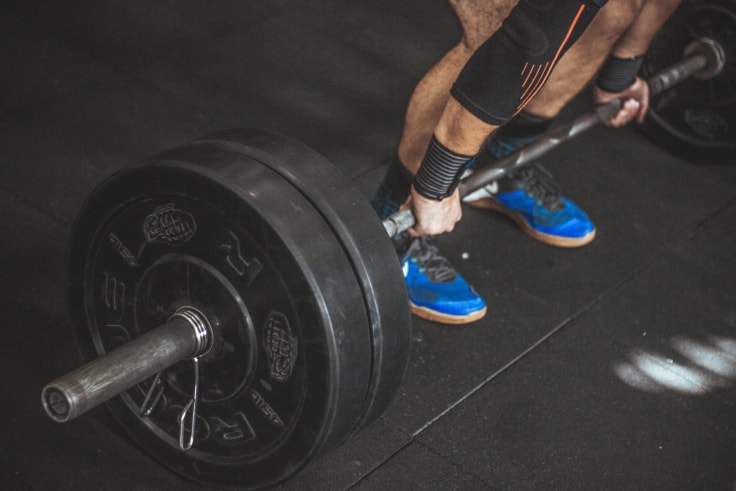The Ins And Outs Of Barbells – Everything You Need To Know

Barbells are arguably the most effective pieces of equipment for building muscle and strength. Understanding the ins and outs of barbells will help you get the most out of this simple yet powerful tool.
Developing muscle and strength is extremely important. Medical researchers have consistently found that it provides considerable health benefits.
For example, a study published in the Archives of Physical Medicine and Rehabilitation found that developing high levels of muscular strength significantly improves your health, and reduces your risk of dying prematurely.
Building a strong and muscular body also helps you to look and feel great too. Well-defined muscles provide an ‘athletic’ look in both men and women, and also help you to lose weight at a faster rate.
Plus, being strong helps you navigate through daily life better. You can lift and carry things more easily, move your own bodyweight with less effort, and most importantly, open stubborn pickle jars with ease.
But to get these benefits, you want the right tool for the job. And that’s where a barbell comes in. Below we’ll go through the things you need to understand to choose the best barbell for you.
The first thing you need to understand is what exactly makes up a barbell.
The Components Of A Barbell
Understanding the different components of a barbell is critical to choosing the right one for you, and then getting the most out of it when completing barbell training.
Barbells can cost anywhere between $80 and $1500 depending on the type you get. So you don’t want to make a poor choice, especially if you’re aiming to stay fit on a budget.
Let’s start really broad, and define what a barbell actually is. A barbell (often called a ‘bar’) is a long piece of machined steel, onto which weight plates are loaded. It’s then used for weight lifting.
1. Sleeves
The sleeves are the portions at each end of the bar onto which weight plates are loaded. Depending on the type of barbell you’re using (more on that soon), the sleeves will either be fixed or rotating and 1 inch or 2 inches in diameter.
2. Shaft
The shaft is the functional area of the barbell between the sleeves. It’s the part of the bar that you grip with both hands when completing most exercises.
3. Knurl
The knurl refers to the cross-hatched pattern that is machined into the shaft. The knurl allows you to get a good grip on the bar and prevents it from slipping. It ranges in type from passive to aggressive, which describes the roughness of the knurl.
4. Center Knurls
Some barbells have a center knurl. This is a small section of knurl in the center of the shaft that helps the bar grip your shirt and remain stable when performing front and back barbell squats.
5. Knurl Marks
They are small sections near each end of the shaft that has no knurl. These marks indicate legal hand placement for the different kinds of competitive weight lifting: Olympic Weightlifting and Powerlifting.
6. Weight Plates
They are not technically part of the barbell, but bars and plates go together like peas and carrots.
Weight plates sit on the bar’s sleeves and provide the extra resistance that builds size and strength in your muscles. Different types of barbells accept different kinds of plates.
Weight plates are generally made from either cast iron or rubber (rubber plates are known as ‘bumper plates’).
7. Collars
Similarly, collars are not part of the barbell but are an essential component in barbell training as they fix the weight plates onto the sleeve, preventing them from sliding off.
Now that we’ve covered the basic components common to pretty much all barbells, let’s take a look at the two different kinds of barbells.

Types Of Barbells
There are two types of barbells:
1. Standard Barbells
Standard bars have fixed sleeves that are 1 inch in diameter. That is, the bar is essentially one continuous piece of steel with no additional parts. As such, standard bars accept standard weight plates, which have 1-inch holes cut into them.
The sleeves on standard bars are either smooth or threaded. Threaded sleeves are made to accept ‘spin lock’ collars, which fix the weight plates onto the bar by screwing on like a nut onto a bolt.
Smooth sleeves use either spring lock or clamp collars, both of which fix the weight plates onto the sleeves via a clamping mechanism.
Threaded sleeves are generally more secure, but slower to load and unload the weight plates. Smooth sleeves are slightly less secure, but allow you to load and unload the plates much quicker.
In truth, standard bars are not for serious weight lifters. Serious lifters don’t waste their time with standard barbells. That’s because they generally aren’t manufactured to high standards of quality.
They corrode quickly, scratch and dent easily, and can bend with loads as small as 200 lbs.
The upside is that standard barbells are relatively inexpensive compared to the other type of barbells, the Olympic barbells.
2. Olympic Barbells
This is where the serious weight lifters play. Olympic barbells have larger sleeves that are 2 inches in diameter. The sleeves rotate around the shaft using either bearings or bushings (metal rings that sit between the inside of the sleeve and shaft).
The purpose of rotating sleeves is to reduce the amount of strain placed on your wrists, especially when lifting very heavy weights.
Olympic bars are used in the two main types of weight lifting competitions: Olympic Weightlifting (that is done in the Olympics) and Powerlifting.
For this reason, Olympic barbells are made to much higher standards of quality than standard barbells and usually have very strict specifications.
For example, good men’s Olympic barbells that could be used in competition will always be machined to have a shaft diameter between 27 – 29 millimeters (depending on the sport), a length of just over 2.2 meters (7.2 ft), and a weight of 20 kilograms (44 lbs).
Women’s barbells that can be used in competitions will be machined to have a shaft diameter of 25 millimeters, a length of 2.01 meters (6.6 ft), and a weight of 15 kilograms (33 lbs).
There are lots of different varieties of Olympic barbells, but these are the basic specifications.
Because of their strict specifications and extra moving parts, Olympic bars are usually considerably more expensive than standard bars. They are also much better quality, hence why they are used by serious lifters.
Now let’s take a look at the properties of a barbell – these will differ greatly between standard bars and Olympic bars.

The Properties Of A Barbell
When we say ‘properties’ of a barbell, we’re referring to the bar’s physical make-up, which in turn determines how the barbell will perform during training (and competition).
Being familiar with the terms used to describe the performance of a bar is crucial to ensuring you get a barbell that is well-matched to your fitness goals and the type of exercises you want to do.
1. Tensile Strength
The tensile strength of a barbell refers to the maximum amount of weight it can hold on the sleeves before bending or breaking.
Tensile strength is measured in Pounds per Square Inch (PSI) and is often expressed as the actual maximum weight a bar can hold in pounds.
A good Olympic barbell will have a tensile strength of at least 170,000 PSI (usually written as 170 KSI), and be able to hold a maximum weight of 1500 lbs.
Anything below 170 KSI or 1500 lbs is likely a cheap and crappy barbell.
Standard barbells rarely have a tensile strength rating because the manufacturers won’t have measured it. As mentioned earlier, standard barbells are known to bend with as little as 200 lbs on the sleeves.
2. Whip
The whip of a bar refers to the amount of flexibility it has. That is, the extent to which it can flex, and return to straight without bending permanently.
The whip is particularly important for Olympic weightlifting, which is extremely explosive in nature.
In contrast, Powerlifters prefer bars with no whip. Barbells are usually described as having ‘no whip’, ‘good whip, or ‘great whip’.
Because standard barbells are generally of low quality, they often can’t flex at all without bending permanently.
3. Finish
Finally, barbells will have a finish, which describes the coating on the shaft and sleeves. This coating has a massive influence on the look and feel of a barbell, as well as how susceptible it is to rusting.
Here are the most common finishes you’ll find on a barbell:
Bare Steel
There is no coating on the bar. Bare steel bars often feel great in the hands, but rust easily and require a lot of upkeep to prevent this.
Black Oxide
Also known as ‘blackening’, black oxide is a coating made from magnetite, which is a rock mineral. It provides a small amount of corrosion protection but does make a barbell look fearsome.
Chrome
This refers to the application of a thin layer of chromium onto a barbell. Chrome has fairly good rust resistance and makes the bar look very nice and shiny. It chips easily though.
Standard barbells almost always have a cheap chrome finish that is very susceptible to wear and tear.
Zinc
This is a common coating on Olympic barbells, primarily because applying Zinc (known as galvanization) is a relatively cheap process that provides very good corrosion resistance and feels nice in the hands.
Zinc coatings are usually either silver or black, both of which make a barbell look pretty spectacular.
Cerakote
Cerakote is a relatively new coating used on barbells and is a ceramic-based material that was originally developed in the firearms industry.
It has a matte finish, rather than the usual shiny finish of other coatings. It provides excellent corrosion resistance and feels absolutely superb in the hands.
Cerakote barbells are usually a little more expensive than barbells with other finishes, except for stainless steel.
Stainless Steel
Stainless steel barbells don’t really have a coating, but rather are made from a unique kind of steel alloy.
This steel alloy develops a think natural layer that provides extremely high resistance to corrosion, as well as wear and tear.
They won’t rust, and they naturally “heal themselves” when scratched. The only barbells made from stainless steel are of the Olympic variety.
Choosing the right barbell for you doesn’t have to be a difficult experience or a guessing game. Armed with the information above, you’ll be able to choose a bar that you love and that helps you achieve your fitness and exercise goals.